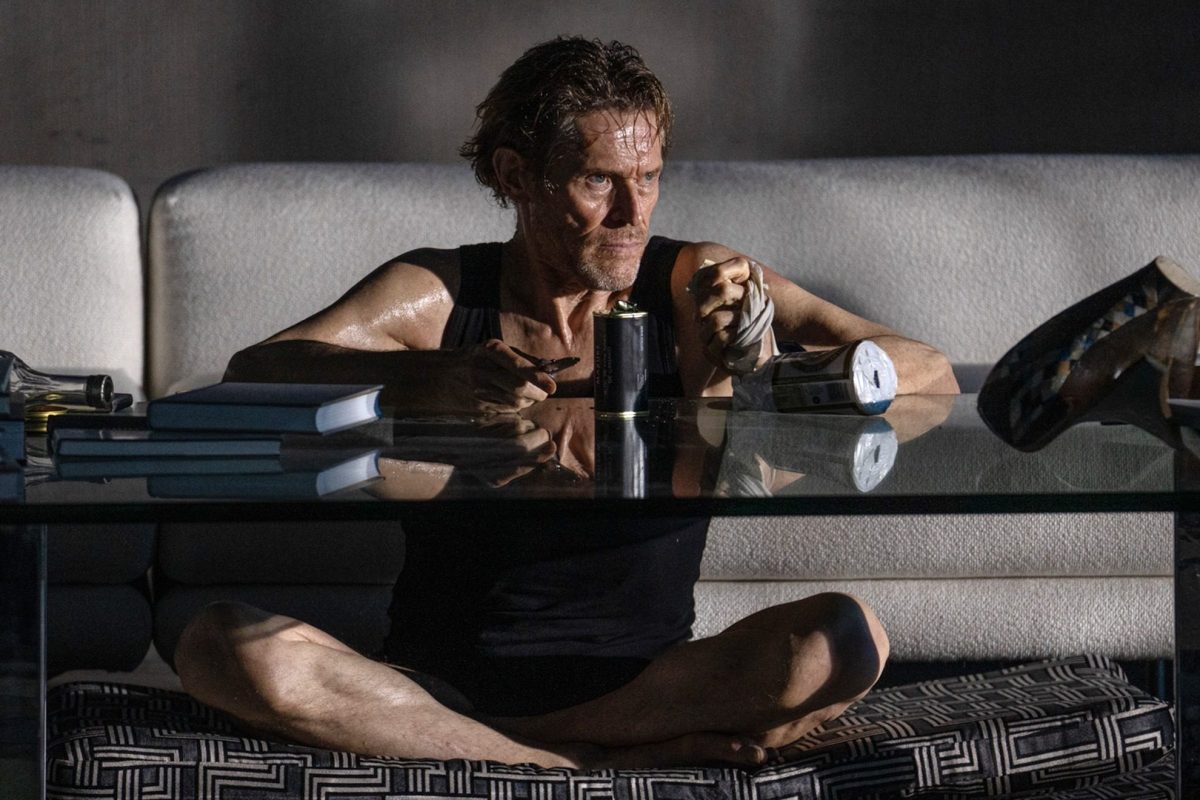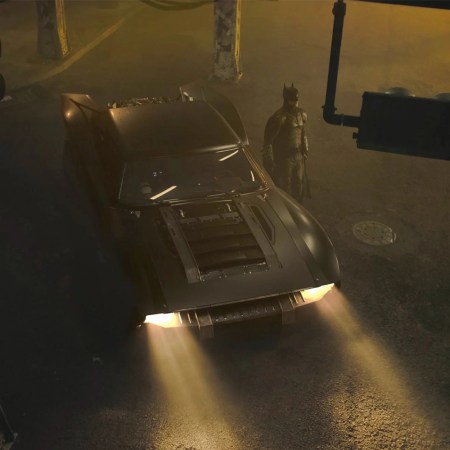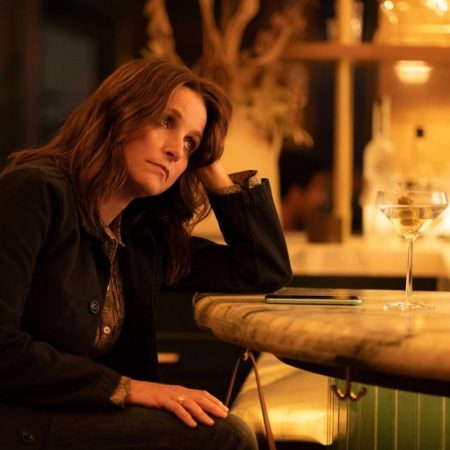Midtown Manhattan may not look like a ghost town to the untrained eye, but atop the hustle and bustle at street level hide wide open spaces. In 2021, the New York Post ran a report that nearly half of the units in the cluster of high-rises around Central Park South known as “Billionaire’s Row” sit unsold, due both to supply exceeding demand and property owners refusing to lower rents. Many of the cavernous penthouses that do have tenants remain vacant anyway, held by Saudi oil barons and other overseas magnates for obscure tax-dodging financial imperatives rather than day-to-day habitation. The absence of that lived-in feeling has imbued the area with a sterile, eerie, even hostile aura. Economically, this is an inhospitable environment, up so high that the air’s too thin for mere middle-class mortals to breathe.
In Vasilis Katsoupis’ debut feature Inside, one of these palatial empty condos sets the scene for a tooth-and-nail battle to survive. An expert burglar named Nemo (Willem Dafoe, in his latest single-location descent into madness following the recent Tommaso and The Lighthouse) breaks into the sleek pied-a-terre of a “star-chitect” busy working in Europe, his collection of priceless artworks left ripe for the taking. With one wrong move, however, Nemo trips an alarm and finds himself sealed in a high-tech prison. Dehydrated, isolated and desperate for a way out, Nemo slips into insanity as he turns the place upside down in search of a weak point. As he loses his grip on his humanity, his environment takes on an inscrutable yet malevolent character of its own, stoic and still as it tries to kill its intrusive occupant.
Ingeniously designed and immaculately dressed, this apartment joins the annals of all-timer film locations from the first pan around to take it all in; it’s also not real. “First of all, no one in the US would give us their penthouse to destroy,” Katsoupis tells InsideHook over Zoom. He and production designer Thorsten Sabel constructed the whole thing on the biggest soundstage Germany had to offer, one of the three largest on the planet, where they could build to their specifications and do with it as they pleased. The fruit of their extraordinary labor is a set that held its own as a scene partner opposite a thespian of Dafoe’s stature, its richness of detail and atmosphere staving off visual inertia in a necessarily stationary project. “This film has two stars,” Katsoupis declares. “Willem, and the set.” In conception and execution, this well-appointed death trap represents a creative feat of willpower on par with the go-for-broke escape attempt depicted onscreen.
“We just had a premiere in New York, and all these people living in the city were asking me, ‘Where can I find this apartment? Where did you shoot this?’” Katsoupis says. “In that moment, I knew we’d done it. That was my biggest fear, that a New Yorker sees it and knows it’s definitely somewhere else. That’s all Thorsten’s work.” The exterior establishing shots hone in on an existent skyscraper — nicknamed the Sabel Tower by Katsoupis as a nod to his trusty collaborator — and from the inside, the windows look out at genuine footage of the New York skyline shot over a handful of visits to town. The outside world looks so authentic in part because of the extra-mile choice to eschew green screens for projection that allowed Dafoe to really look at something when he gazes at the freedom so close and yet so far.
Housing the projectors for what Sabel calls a “moving backdrop” required a two-meter platform under the contiguous block of rooms, so he and Katsoupis had to blueprint from the ground up in the most literal sense. Exhausting all his options, Nemo activates the sprinklers and douses the entire set in nearly 20 centimeters of sitting water, which tasked Sabel with waterproofing every crack and seam. The nerve-wracking shoot had no CGI to fall back on and only one try to nail it; with a tone of great satisfaction, Sabel shares that not a single drop of water left the stage. “You remember, the first time we started on the bedrock construction?” Sabel asks Katsoupis. “You turned to me and said, ‘Ah, fuck, what did we do?’”
The steel-reinforced walls and shatterproof windows cover 700 square meters with ceilings eight meters high, squeezed onto the largest facility at MMC Studios in Cologne. Katsoupis and Sabel spent 12 weeks plotting every speck of a fully-realized, fully-functional space through which Dafoe could freely wander for a spontaneous, organic performance. “You can walk the whole apartment,” Katsoupis says. “The narrow space for a secret room, even that’s connected too. It was all one big labyrinth. One to one scale.” The self-proclaimed Brutalism fans turned to the severe cement-and-metal modern architecture of Gottfried Böhm and Oscar Niemeyer for a sleekness that also made sense as a jail cell. “I went with Thorsten to all these buildings, one cathedral by Böhm, because for me it was important to understand the dimensions of these pieces,” Katsoupis adds. “I needed to feel their size.”
Even with the owner out of sight, telling touches convey the personality of a man distorted by extreme wealth. A jumbo photo portrait poses him, his daughter and their dog in puffed-up self-seriousness Nemo deflates with mustache-and-devil-horns graffiti. One canny flourish waits behind the door to the panic room, where the sparse shelves hold mouth-parching caviar instead of bottled water. There’s an absurdity to this level of luxury, perfectly encapsulated by a fridge that announces its door has been left open too long by blaring the Macarena.
“When we were writing the script with Ben Hopkins, we thought about a device playing a silly song,” Katsoupis recalls. “We liked Macarena, because after a little while, it starts to feel like the apartment is laughing at Nemo, trolling him. That was the initial idea. But I was looking on the Internet, and I saw some videos on YouTube, reports that the Macarena was being used by the American army in psy-ops to befriend the enemy. They go into a village, and to show the people they’re friendly, they’ll do the Macarena with wives and kids. It’s a way of showing that we’re not the bad guys, and then this happened again with the protests in the US in 2020. The National Guard used this to try to share a moment with the protesters. It has a connotation, and maybe the house knows this as well, trying to befriend its intruder.”
The unseen owner’s eclectic, refined tastes belie a lack of basic practicality, his stale home treated more as a containment unit for his art than a comfortable living arrangement. “The owner is not just a rich person; he’s an intellectual guy with a real knowledge of art and aesthetics,” Katsoupis explains. “It’s important in his life. So that’s why he surrounds himself with these expensive works, though he’s always traveling. The apartment is quite austere… This art is the soul of the owner, and the eyes of the apartment. We have many pieces that look at Willem.”
The production team enlisted the services of art curator Leonardo Bigazzi to assemble a mixed-media treasure trove spanning painting, sculpture, video art and one wading pool. The destructive nature of the script demanded that they commission reproductions of each work, in some cases from the original artists and in others carried out with their permission by someone else. “It wasn’t easy, because the artists are very strict about their guidelines for accurately copying the work,” Sabel says. “Some were handled by the artist’s own studio, but some had to be done by us. This was a difficult procedure, where all the colors have to match exactly, be mixed correctly for the paintings.”
The 10 Best Movies and TV Shows at SXSW 2023
From surrealist comedy to a nun doing battle with AI, this year’s festival had it allAs any collector will tell you, every piece has a story, and every selection from Bigazzi likewise bore a symbolic significance. Take David Horvitz’s “all the time that will come after this moment,” which renders his own handwriting of that phrase in oversized neon. “The piece from Horvitz has an irony to it, which starts a dialogue with Nemo about time,” Katsoupis says. “We lose time in the space, like falling into a time warp. I don’t want the audience to know how many days it’s been. We never thought of including a ‘Two Weeks Later’ subtitle or anything like that. That would destroy the atmosphere. What’s magical, though, and this is the gods of filmmaking protecting us, is that in the raining sprinkler scene, half of the neon blinked off. That wasn’t intentional, it was a short-circuit in the system from the water, and it wasn’t dangerous. But it was perfect, only half the sentence was left: After This Moment.”
As his brain slowly turns to jelly, Nemo creates a masterpiece of his own in the precarious tower of repurposed furniture he uses to climb to a skylight, the last possible chink in the security system. Thorsten and Katsoupis selected the decor specifically for its potential structural integrity, cataloguing it all in the first scene like a whole Pottery Barn’s worth of Chekhov’s furnishings. The tower stands as a monument to humankind’s inextinguishable will to live, an outgrowth of one man’s delirium, a stories-tall metaphor for the arbitrary usefulness of wealth. “We’ve been asked about recreating the tower somewhere that it can be appreciated,” Sabel says. “Maybe we should.”
The final shots take stock of the ransacked apartment, so much more than a matter-of-fact location in its suggestive disarray. The simple narrative of a guy trying to bust out of a locked room lends itself to a myriad of interpretations: an inner wrestling match with long-repressed demons, a critique of art-world pretension in the face of the form’s primal power, a deadpan slapstick comedy treating viewers to the sight of Willem Dafoe performing mechanical tasks for 90 minutes. Katsoupis sees this zone as a self-sustaining ecosystem, befouled by its reckless inhabitant as he burns through resources without consideration for the future. Considering its fictitious placement in that capitalism-strangled corner of Manhattan, the condo lends itself perfectly to a parable about the ruinous effects we have on the places we call home. “I think of it as a small climate,” Katsoupis says. “It is a lonely island.”
This article was featured in the InsideHook newsletter. Sign up now.
























